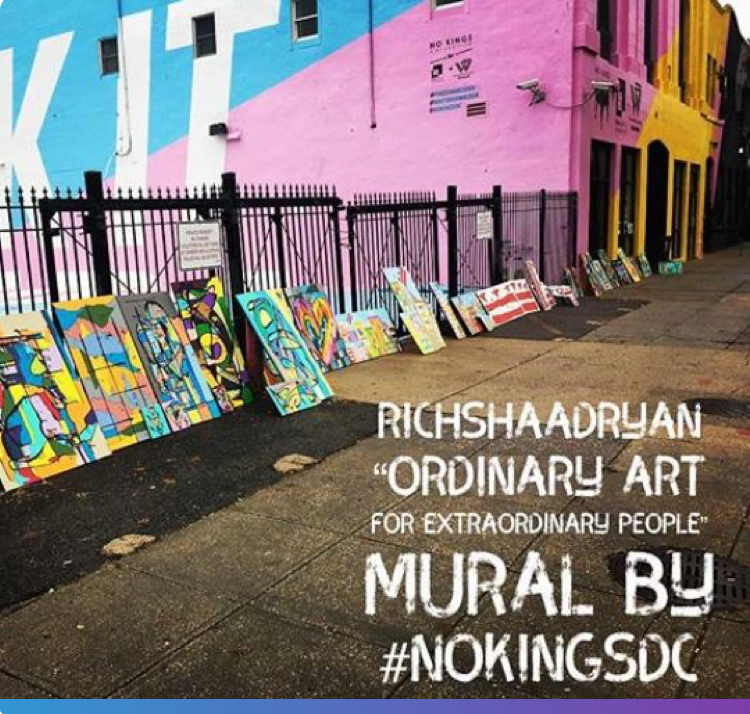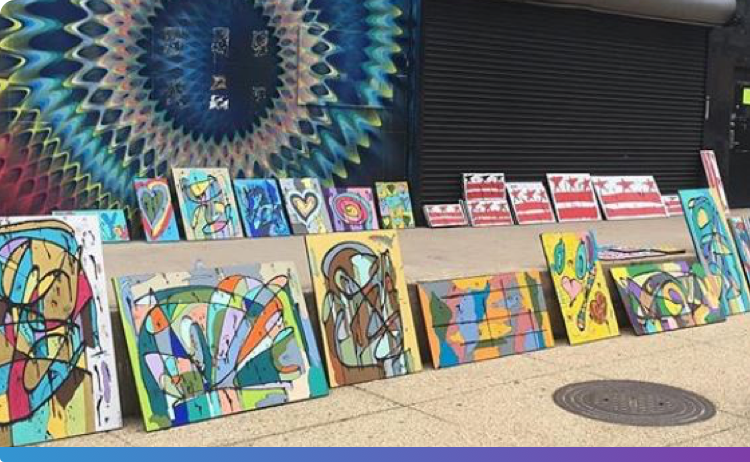As part of Whitman-Walker’s 40th anniversary, officially January 13, 2018, we’re sharing 40 stories to help tell the narrative of Whitman-Walker in community. We’d like to formerly introduce you to Richshaad Ryan. Richshaad is a DC-based artist who uses his art to spread good energy, peace and love to his community. He’s a firm believer that we all have something to learn from each other. Richshaad uplifts the idea that we should, “love and live every day to fullest because we don’t know when the end is. Be kind. We all human.”
You may have run into Richshaad on 14th Street, as he can often be found sharing his latest pieces near the Elizabeth Taylor Medical Center at 14th and R Streets, NW. Every year on his birthday, Richshaad gets an HIV test, often with Whitman-Walker. It’s his way of being in control of his sexual health after an exposure to HIV a few years back. He’s the previous co-owner of Planet Chocolate City, a t-shirt shop in DC that had locations on H Street and Georgia Avenue. Keep up with Richshaad and his latest artwork on Instagram at @richshaadryan or at www.richshaadryan.com.
Click the orange play button below to hear Richshaad’s November 27, 2017 oral history – a recorded interview with an individual having personal knowledge of past events. Thank you to the DC Oral History Collaborative for supporting the collection of this oral history.
Five Quotes from Richshaad’s Oral History
On Sex Education in the Eighth Grade in the 1980s:
Well, back you know, sex like, we really didn’t talk about sexual health in our school back then. It was a different element. You know, I don’t remember anything about sexual health back then. And I’m not – maybe we did talk about it, but it was so like minute that it wasn’t a lasting memory on me. I think when I got to college probably my sophomore year, it was more like, it was starting. You know they were pushing sexual education, condom, you know protecting yourself from diseases and also it wasn’t the internet, so I think it was harder to reach a lot of people at one time. You know how now you can have a blast off on Instagram ‘hey we doing this, we have the truck here testing for HIV, other diseases’ or there’s so many different avenues to promote it now, that it’s totally different. My father taught me, you know, about using a condom and everything else was trial and error. I mean, that was pretty much it.”

Hannah Byrne, Oral History Intern at Whitman-Walker Health, interviews Richshaad Ryan as he sells his art in front of the Elizabeth Taylor Medical Center. Photo by @kundalini on Instagram.
On “Gym Jams” at Virginia State University from ’86-’90:
“Oh yeah, yeah, the parties. So when I went to college, we had a lot of people from New York, New Jersey, Delaware and down South, North Carolina, so it was like the beginning. I’m not going to say the beginning of Hip Hop, but it was like when everything was picking up because I guess when Hip Hop first started, no one really took it seriously. Cause they was like ‘what is this? Is it going be a like a fly-by-night music, you know, genre or.’ So with the gym jams, a lot of, mainly every artists that was out the way for their exposure where, they would go to like all the historical black colleges and perform. So we would have gym jams all the time. Like, I mean every, I seen so many Salt N’ Peppa, EPMD, Kurtis Blow, Kool Moe Dee, LL Cool J. All of them were, use to come to our school, cause we had big, we had a large New York, New Jersey contingency of students, so and then it would just be, what’d they do, they clear, they just push all the bleachers back and it’d just be like a big, like a big house party, I would call it. So that use to be fun times.”

Richshaad sets his art up outside the Elizabeth Taylor Medical Center and #LizLot “Work It Gurl” mural by No Kings Collective.
On How the African American Community Saw Max Robinson and Magic Johnson:
“…you know in the African American community like as you know HIV is really frowned on. It’s like you got – people think you can get it from a hug. The education – is built up, it’s better now far as everybody understand how it works. How it do things so you don’t catch it. Or you know, people live their whole life with it. So it’s different cause of the medicine and the education. The different groups have sent out – it’s more open.”
“I would hate to pass it on to someone else. If I have it, alright so what? I’ll deal with it. Find someone who does have it, find protective ways I can still have sex, whatever. But I don’t know. I wouldn’t want to just pass it on to somebody because that’s not their choice. I just kept going back and she was like if you’re not having sex, you’re not going to have it. I went back. I went back. I went back. Then I started after probably like the 11th – 10th time I started being like you can’t live like this. You can’t – you gotta rebound. You have to find a way. That’s when like – the whole time my faith was still strong, but I was skeptical on whether I had it or not.”

A variety of art by Richshaad Ryan.
On How His Community Views HIV Today:
“The main thing I would say the difference is now if someone, say someone such and such got HIV, you don’t immediately think equals death. You don’t initially think they got the cooties or whatever. They don’t – I think it’s becoming more. People are not scared of it as much far as like when someone has it. Man, nah don’t let her drink out your glass. Just certain things. Stigmatisms or whatever. And you know what, it’s becoming – it’s becoming more like – what would I say? It’s more – it’s just more stuff on it now. World AIDS Day. It’s just more information, more marketing material, I would say more education on it. I’m sure they do it in all the schools now. So, it’s becoming a word – a word that you’re not afraid to say or afraid to talk to someone or hug someone or show love to someone who may have it. I think it’s getting much better. Way better like far as conversation everything starts with a conversation to understanding. I think the information is helping people understand it more. Instead when it first started hitting they was just like man they gonna – they die. It’s like even with other major diseases – cancer and all them it’s a different understanding. What type do you have? What kind of chemo are you going to do? Are you going to do natural? I think with the HIV and AIDS it’s the same thing. It’s becoming more of a household name and the understanding of how to deal with it. It’s not like – it’s not a sign of death.”


